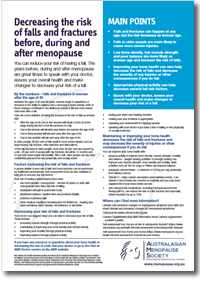Decreasing the risk of falls and fractures before, during and after menopause
 MAIN POINTS
MAIN POINTS
- Falls and fractures can happen at any age, but the risk increases as women age.
- Falls in older people are more likely to cause more severe injuries.
- Low bone density, low muscle strength and poor balance are more likely as women age and increase the risk of falls.
- Improving your bone health can also help decrease the risk of falls and decrease the severity of any injuries or other consequences if you do fall.
- Appropriate physical activity can help decrease several fall risk factors.
- Speak with your doctor, assess your overall health and make changes to decrease your risk of a fall.
![]() Decreasing the risk of falls and fractures before, during and after menopause67.29 KB
Decreasing the risk of falls and fractures before, during and after menopause67.29 KB
You can reduce your risk of having a fall. The years before, during and after menopause are great times to speak with your doctor, assess your overall health and make changes to decrease your risk of a fall.
By the numbers – falls and fractures in women after the age of 40
Between the ages of 40 and 60 years, women begin to experience a decrease in the ability to balance and a decrease in bone density. Both of these changes contribute to the likelihood of both a fall and more severe outcomes after a fall. Here are some statistics showing the increase in the risk of falls as women age:
- After the age of 50, one in two women will break a bone at some stage during the rest of her life because of a fall.
- One in five women will fall each year before she reaches the age of 60.
- One in three women will fall each year after the age of 65.
- One in two women will fall each year after the age of 80.
In older people, 30 per cent of falls result in more severe injuries such as head trauma, hip fracture, other fractures and dislocations. Of the hip fractures in older people, more than 90 per cent are caused by a fall – 25 per cent of people with hip fractures die within 12 months and 25 per cent never regain full mobility. After a fall, older people can also lose confidence and become less physically and socially active.
Factors increasing the risk of falls and fractures
A proper review of your risk of falls and bone fractures can be performed by healthcare professionals. Self-assessment tools are also available to help you to uncover any risk factors. Your risk of having a fall increases if you have:
- low bone density / osteoporosis – women 60 years or older with osteoporosis have twice the risk of falling
- decreased strength in your lower body
- decreased balance, reaction time and postural stability
- a history of previous falls
- other medical conditions including (but not limited to) – hearing and vision problems, heart disease, incontinence or dementia.
Decreasing your risk of falls and fractures
Your doctor can suggest steps you can take to decrease your risk of falls. These include:
- increasing muscle strength through physical activity
- maintaining or improving your bone density (see section below)
- improving your mobility through physical activity
- improving balance through physical activity
- having your vision and hearing checked
- making sure your footwear is appropriate
- reviewing your environment for tripping hazards
- speaking with your doctor if you have a fear of falling or feel physically or socially restricted.
Maintaining or improving your bone health decreases the risk of falls and fractures and may decrease the severity of injuries or other consequences if you do fall.
You can improve your bone health with:
- physical activity to improve bone density, muscle strength, mobility and balance – weight-bearing activities or strength training can improve your muscle strength, bone density and mobility, while activities such as Tai Chi, yoga or Pilates can improve balance
- adequate calcium intake – a minimum of 1200g per day, preferably from dietary sources
- Vitamin D – helps calcium absorption and maintains bones. Low vitamin D blood levels are common in Australia and you may need supplements if your blood levels are low
- anti-osteoporosis medications, including menopausal hormone therapy (MHT), can reduce the risk of a first fracture and especially further fractures by up to 70%.
Where can I find more information?
Lifestyle and behaviour changes for menopausal symptoms (See AMS fact sheet Lifestyle and behaviour changes for menopausal symptoms)
Osteoporosis (healthybonesaustralia.org.au)
Calcium Supplements (See AMS information sheet Calcium supplements)
Self-assessment tool: Are you at risk of osteoporotic fracture?
Self-assessment tool: Know your bones
If you have any concerns or questions about options to manage your menopausal symptoms, visit your doctor or go to the Find an AMS Doctor service on the AMS website.

NOTE: Medical and scientific information provided and endorsed by the Australasian Menopause Society might not be relevant to an individual’s personal circumstances and should always be discussed with their own healthcare provider. This Information Sheet may contain copyright or otherwise protected material. Reproduction of this Information Sheet by Australasian Menopause Society Members, other health professionals and their patients for clinical practice is permissible. Any other use of this information (hardcopy and electronic versions) must be agreed to and approved by the Australasian Menopause Society.
Content updated March 2019
